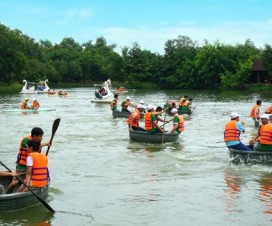If you’ve ever considered it, or been tempted to climb, Halong Bay is a superb place to go for it – the karst cliffs here offer exceptional climbing amid stunning scenery. Most climbers in Cat Ba are complete novices, but as the instruction is excellent, many leave Cat Ba completely bitten by the bug.
Find out Top Halong Bay Tours with fascinating itineraries and flexible duration at favorable price
You don’t need great upper-body strength to climb, as you actually use your legs far more. The karst limestone of Halong Bay is not too sharp and quite friendly on the hands, and as many of the routes are sheltered by natural overhangs that prevent the climbable portion of the rock from getting wet, climbing is almost always possible, rain or shine.
A few inexperienced locals may offer climbing excursions to new arrivals on Cat Ba, but beginners should sign up with the experienced crew at Asia Outdoors (above).

Rock climbing in Cat Ba
Climbing opportunities for beginners are located on walls inland on Cat Ba Island or out on beautiful Lan Ha Bay. You’ll be kitted up with a harness and climbing shoes, given instruction and taught the fundamentals of the climbing and belaying techniques, then given a demonstration. Then it’s over to you (with your climbing instructor talking you through each move and anchoring you, of course!). Most people are able to complete a couple of climbs at Hai Pai and Moody’s Beach, which are both ideal for beginners.
Check out Halong – Lan Ha bay tour for by kayaking and rock climbing in 3 days 2 nights
The vertical cliffs of Halong and Lan Ha Bays are also perfect for deep-water soloing, which is basically climbing alone, without ropes or a harness, and using the ocean as a water bed in case you fall. This is obviously only for experienced climbers, and it’s essential to know the depth of water and tidal patterns. We’ve heard reports of some climbers being injured falling into shallow waters, so it’s vital to attempt deep-water soloing only with an experienced crew like Asia Outdoors. It’s customary to finish a solo climb with a controlled free fall (or ‘tombstone’) into the sea and a swim back to the shore, or your boat.
(Source: Lonely Planet Guidebook)




